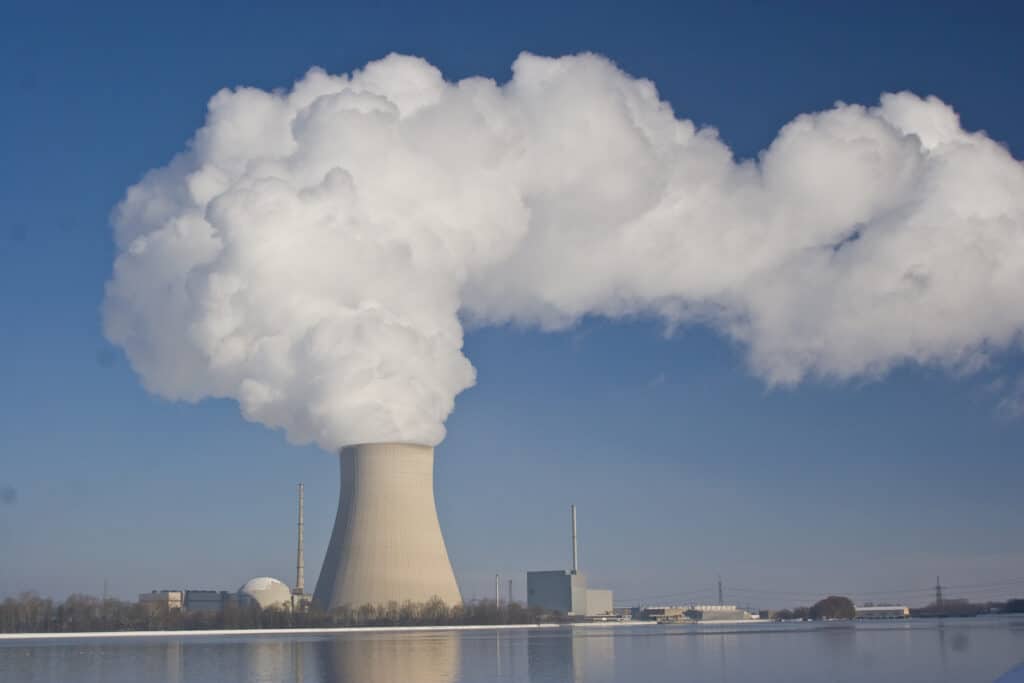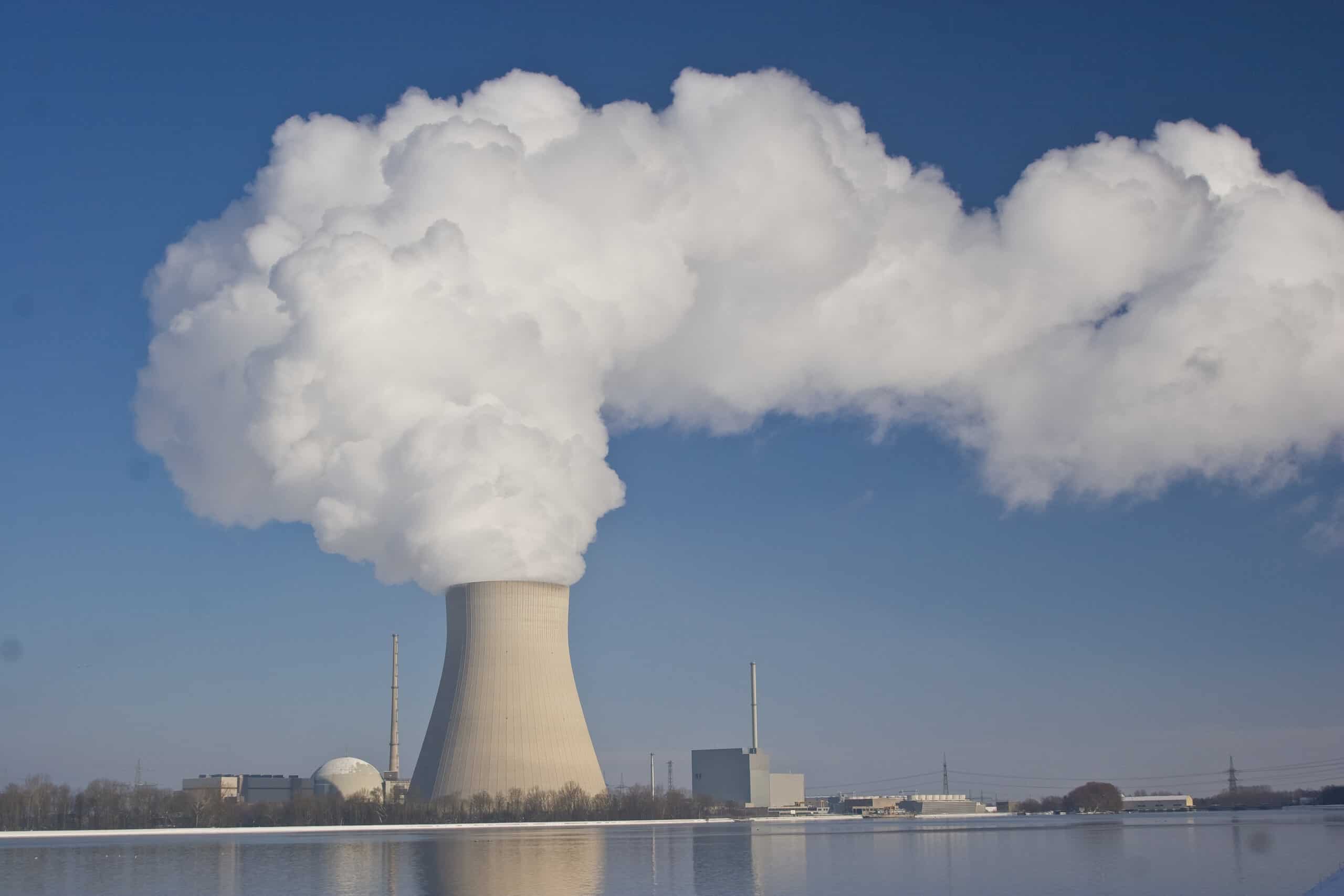Introduction
Nuclear power is both a huge source of electricity production and revenue in the United States. While nuclear power is a clean energy resource, it does not come without faults. Major environmental and human health risks go hand in hand with nuclear energy. Furthermore, nuclear power has been at the forefront of some major scandals, especially in the state of Ohio. Discover Ohio’s largest nuclear power plant in the following article. Let’s explore why the plant has earned attention from the public for over a decade.
What is Nuclear Power?

Nuclear power plants do not burn fossil fuels or release greenhouse gases into the atmosphere. Therefore, many believe that nuclear power is an important strategy for slowing climate change.
©CoolKengzz/Shutterstock.com
Nuclear power results from a series of energy releases that come from nuclear fission or nuclear fusion. During nuclear fission, which is the process that power plants use to create nuclear energy, atoms are split. An atom contains three central elements. These elements are protons, neutrons, and electrons. Protons and neutrons make up the core of an atom, while electrons orbit the core.
When creating nuclear energy, the protons, and neutrons that make up an atom’s core, or the nucleus, are split by other neutrons. Neutrons hit an atom’s nucleus, causing a split between protons and neutrons. The neutrons that result from this split go on to split other nuclei of other atoms. Therefore, a chain reaction results. The previously split neutrons begin to split other atoms, which go on to split even more atoms. Throughout this process, radiation and heat are released from the splitting of an atom. These two factors create what we call nuclear energy.
How Does a Nuclear Power Plant Operate?
Uranium is an element on the periodic table, and nuclear power plants use uranium atoms to harness nuclear energy. When uranium atoms are split, heat from the reaction creates steam. This steam is used to turn a turbine, which generates electricity. The resulting electricity is then used to power homes and businesses in a specific area near the power plant.
5 Nuclear Energy Facts
- Nuclear power plants do not burn fossil fuels nor release greenhouse gases into the atmosphere.
- Nuclear power is considered a clean energy resource.
- Nuclear power is much cheaper than most of the numerous ways to produce electricity on a large scale.
- Around 20% of the electricity produced in the United States comes from nuclear energy.
- Nuclear power is one of the nation’s largest carbon-free ways to produce electricity.
Where is the Perry Nuclear Power Plant Located on a Map?
The Perry Nuclear Power Plant is located in the city of Perry, Ohio, which borders the shore of Lake Erie. Perry is just northeast of the major city of Cleveland.
The Largest Nuclear Power Plant in Ohio
Perry Nuclear Power Plant is the largest plant in the state of Ohio, and it is located in Perry, Ohio, just northeast of the city of Cleveland. The city of Perry has a population numbering 1,598 residents as of 2021. The plant began construction during the fall of 1974. Perry Nuclear Power Plant received its operating license on November 13, 1986, and the plant is expected to renew its license in November of 2026. The plant’s site covers 1,100 acres, and it is owned by Energy Harbor, previously known as FirstEnergy Solutions, before its rebranding. The plant produces approximately 9,703-gigawatt hours of electricity per year as of 2021.
While the plant is currently operational, there have been rumors about a permanent shutdown of Perry Nuclear Power Plant in the past. According to Exelon Corporation, Energy Harbor threatened a permanent shutdown of the plant at one point. Supposedly, the plant had been losing value for some time, and keeping it open didn’t appear to be beneficial to the community. However, Perry, Ohio, residents believed that the plant brought in revenue that was necessary to keep the district alive. Perry Nuclear Power Plant offers valuable revenue that helps to fund schools, and it employs many in the small Perry community.
Largest Nuclear Power Plant in Ohio: Controversies

The Perry Nuclear Power Plant produces approximately 9,703 gigawatt hours of electricity per year as of 2021.
©Eder/Shutterstock.com
Nevertheless, Perry’s Nuclear Power Plant has been the center of controversy. In the year 2020, Ohio House speaker Larry Householder was arrested for his involvement in a bribery and money-laundering scheme in connection with Perry Nuclear Power Plant and another power plant in Ohio. When the two nuclear power plants struggled financially, Householders and other politicians attempted to bail out the plants.
In summary, Householders aided in a scheme to charge taxpayers an extra fee on their electricity bills that would be given directly to the plants. The fees would funnel over $150 million yearly to the plants to keep them operating smoothly. Through this process, the bribing of the power plants allowed Householders and other politicians to remain in power and gain more money to finance their campaigns. In fact, Energy Harbor donated to Householder’s campaign and to other supporting Republican politicians.
Largest Nuclear Power Plant in Ohio: Complications
Additionally, Perry Nuclear Power Plant has suffered other complications. In 2010, a fire broke out at the plant, which caused Energy Harbor to reduce power to the plant to less than 70%. While no one was seriously injured during the fire, two men were hospitalized due to heat stress. The fire was put out after around four hours, but the incident did make some people anxious about the plant’s ability to operate.
In April 2021, Perry Nuclear Power Plant faced an unconventional challenge. A man from Michigan named Michael Fogelsong drove onto the plant site in a pickup truck with a trailer attached. Fogelsong claimed to have a bomb inside the trailer, as though he was planning to blow up the nuclear power plant. After the Lake County Bomb Squad inspected the trailer, it was obvious that Fogelsong did not have a bomb with him. Fogelsong was arrested for aggravated trespass and for making false alarms. Perry Nuclear Power Plant maintained that there was no safety threat to the power plant or to the surrounding community.
Wildlife Near Ohio’s Largest Nuclear Power Plant
In 1993, portions of the Perry Nuclear Power Plant site were dedicated as an urban wildlife sanctuary. Some animals that live in the sanctuary include belted kingfishers, waterfowl like ducks and geese, and herons. In addition, spotted turtles, which are an endangered species within the state, live in a wetland on site. Spotted turtles are most common on the East Coast and near the Great Lakes. The species is characterized by its yellow polka dots, which can be found on its outer shells. Some environmental threats that engender spotted turtles include habitat loss, poaching, and the pet trade.
Is Ohio’s Nuclear Power Plant Dangerous to the Environment?

Radioactive waste must be kept in cooled pools of water to maintain stability, and loss of cooled water could result in a nuclear meltdown.
©leshiy985/Shutterstock.com
One issue with Perry Nuclear Power Plant is that it produces radioactive waste. Radioactive waste is difficult to dispose of because it harms the environment, humans, and wildlife more than typical waste or trash. Burying radioactive waste, depositing it into landfills, or even funneling it into oceans can be fatal. For instance, radioactive waste can seep into groundwater and poison it, putting humans and animals at risk.
Radioactive waste at Perry Nuclear Power Plant is kept on site. It must be kept in cooled pools of water to maintain stability, and loss of cooled water could result in a nuclear meltdown. Nuclear meltdowns occur when the nuclear core of a power plant is damaged due to overheating. During nuclear meltdowns, radioactive waste can be released into the atmosphere and spread to neighboring areas. Radiation that is spread through the atmosphere can be fatal or cause extreme illness. For instance, a nuclear meltdown in Chornobyl, Ukraine, in 1986 resulted in many fatalities, loss of plant and animal life, and evacuation of the city and its surrounding area to this day.
Largest Nuclear Power Plant in Ohio: Additional Environmental Issues
In addition, the seismic risk at Perry Nuclear Power Plant measures 1 in 47,619 as of 2010. Seismic risk measures the chance of an earthquake causing damage to the core of a nuclear reactor within a nuclear power plant. While the Nuclear Regulatory Commission’s seismic risk estimate of Perry Nuclear Power Plant means that extreme damage to the nuclear core is highly unlikely, it wouldn’t be impossible.
Some have speculated that the seismic risk of the Perry Nuclear Power Plant is much greater than what has been reported. According to an Associated Press assessment of the Nuclear Regulatory Commission’s estimate, the plant is 38% more prone to core damage than it was around 20 years ago, as of 2009. Knowing this information, people have called on Perry Nuclear Power Plant to prioritize safety in the future.
Overall, nuclear power plants come with a multitude of risks. From seismic risk to radioactive waste, clean energy does not always signify fewer consequences. While Perry Nuclear Power Plant claims to be dedicated to public safety, its past scandals and incidents have caused people to question its commitment to responsible energy production.
Thank you for reading! Have some feedback for us? Contact the AZ Animals editorial team.








